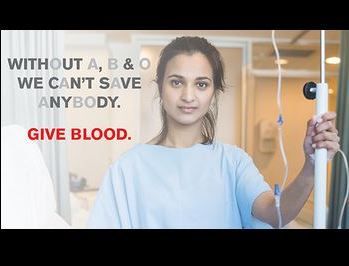
Publisher:
Bonnie King
CONTACT:
Newsroom@Salem-news.com
Advertising:
Adsales@Salem-news.com

~Truth~
~Justice~
~Peace~
TJP
Jun-12-2018 16:00

 TweetFollow @OregonNews
TweetFollow @OregonNews
Red Cross Says: A's, B's and O's are missing!
Salem-News.comRed Cross campaign calls for new blood donors to fill the Missing Types
 FIND A BLOOD DRIVE: Click here |
(PORTLAND, Ore.) - As part of an international movement, the American Red Cross is launching the Missing Types campaign today to recruit new blood donors – and those who have not given recently – to ensure lifesaving blood is available for patients.
During the Missing Types campaign, the letters A, B and O – the main blood groups – will disappear from brands, social media pages, signs and websites to illustrate the critical role every blood donor plays. When the letters A, B and O vanish from everyday life, the gaps are striking. And when A, B and O blood types are missing from hospital shelves, patient care could be impacted.
“Unfortunately, blood shortages still happen and the number of new Red Cross blood donors is shrinking each year,” said Cliff Numark, senior vice president, Red Cross Blood Services.
“That’s why the Red Cross is asking those who have never donated blood and those who haven’t given in a while to make a lifesaving donation. You are the missing type patients need.”
Don’t wait until the letters A, B and O go missing from hospital shelves. Join the #MissingType movement today – make an appointment to give blood by visiting RedCrossBlood.org/MissingTypes, using the Red Cross Blood Donor App or calling 1-800-RED-CROSS (1-800-733-2767).
Survey reveals public misconceptions about blood needs and donation A recent survey, conducted on behalf of the Red Cross, revealed a troubling disconnect between the public’s perception of blood donations and the realities of patient transfusion needs.
- Three-quarters (74 percent) of the public underestimate how frequently blood transfusions occur.* Most people perceive blood is needed in the U.S. every 15 minutes or even every hour or two hours when in fact, every two seconds, someone in this country needs blood.
- Nearly half of the public (45 percent) know someone who has been helped by a blood transfusion.* Yet only three percent of the U.S. population donates each year.
- More than one-third (35 percent) of the public has never considered that blood may not be available when they or a loved one need it.* Blood shortages are not uncommon in the United States and can only be prevented when more people roll up a sleeve to give.
- More than half (53 percent) of the public believe they need to know their blood type to donate.* Good news – Potential blood donors do not need to know their blood type before giving blood. After individuals give blood, the Red Cross provides each donor their blood type. By joining the #MissingType movement, donors can find out their blood type this summer.
Missing letters can lead to delays in treatment
Lily Dotson and her family know how serious blood shortages can be for patients. During Lily’s 2 1/2 years of treatment for high-risk leukemia, her family was told twice that the hospital didn’t have the blood or platelets she needed and that she would have to wait for transfusions. It was incredibly frustrating and eye-opening for Lily’s mom, Susie Dotson.
“People automatically think blood is there. They don’t realize we’re relying on their blood donation,” said Dotson. “Lily needed blood products just as much as the chemo or the treatment.”
Lily, now 11, has been cancer-free for four years and is preparing to enter middle school this year.
Each day, blood and platelets are needed for accident and burn victims, heart surgery and organ transplant patients, and those like Lily who are receiving treatment for leukemia, cancer or sickle cell disease. The Red Cross must collect more than 13,000 blood donations every day for patients at approximately 2,600 hospitals across the country.
New donors needed!
Every two seconds, someone in the U.S. needs blood. But for the past four years, new Red Cross donors have declined by about 80,000 each year. This is not just a Red Cross trend, but a challenge blood collection organizations face across the country and around the world.
Donating blood is a simple process and only takes about an hour from start to finish.
- Registration: Sign in, show ID and read required information.
- Health check: Answer questions and receive a mini-physical.
- Donation: Giving a pint of blood only takes about eight to 10 minutes.
- Refreshments: Donors enjoy snacks and relax before resuming their day.
FIND A BLOOD DRIVE: Click here
Articles for June 11, 2018 | Articles for June 12, 2018 | Articles for June 13, 2018
Quick Links
DINING
Willamette UniversityGoudy Commons Cafe
Dine on the Queen
Willamette Queen Sternwheeler
MUST SEE SALEM
Oregon Capitol ToursCapitol History Gateway
Willamette River Ride
Willamette Queen Sternwheeler
Historic Home Tours:
Deepwood Museum
The Bush House
Gaiety Hollow Garden
AUCTIONS - APPRAISALS
Auction Masters & AppraisalsCONSTRUCTION SERVICES
Roofing and ContractingSheridan, Ore.
ONLINE SHOPPING
Special Occasion DressesAdvertise with Salem-News
Contact:AdSales@Salem-News.com

googlec507860f6901db00.html



Terms of Service | Privacy Policy
All comments and messages are approved by people and self promotional links or unacceptable comments are denied.
[Return to Top]
©2025 Salem-News.com. All opinions expressed in this article are those of the author and do not necessarily reflect those of Salem-News.com.